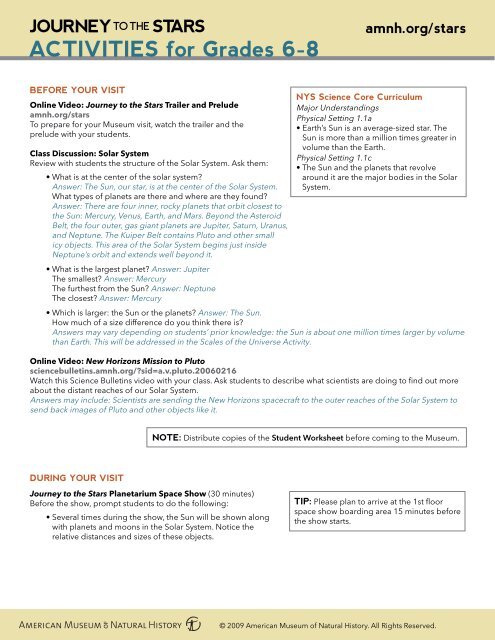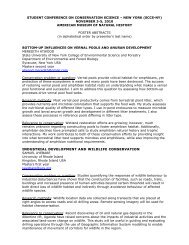ACTIVITIES for Grades 6-8 - American Museum of Natural History
ACTIVITIES for Grades 6-8 - American Museum of Natural History
ACTIVITIES for Grades 6-8 - American Museum of Natural History
Create successful ePaper yourself
Turn your PDF publications into a flip-book with our unique Google optimized e-Paper software.
Investigate Sizes and Distances <strong>of</strong> Celestial Objectsamnh.org/starsSTUDENT WORKSHEET <strong>for</strong> <strong>Grades</strong> 6-8The circles on this page are scaled to accurately represent the relative size <strong>of</strong> objects in our SolarSystem. (Notice that one <strong>of</strong> circles is too large to fit on the page!) Observe the relative sizes <strong>of</strong> theplanet models and the Hayden Sphere, which represents the Sun.Label each circle with the name <strong>of</strong> the celestial object it represents (use the planet models and theHayden Sphere to guide you). Then look at the panels that list the actual sizes (diameters) <strong>of</strong> eachobject that you’ve labeled. Record the actual size <strong>of</strong> each object next to the name.Find the panel showing the Earthand the Sun. How many Earths couldfit in a hollowed-out Sun? _______________________Find the picture <strong>of</strong> theMoon on the panel tothe right <strong>of</strong> the planetpictures. Using thein<strong>for</strong>mation on thepanel, draw a circle<strong>of</strong> the appropriatesize next to the circlethat you have alreadylabeled as Earth.© 2009 <strong>American</strong> <strong>Museum</strong> <strong>of</strong> <strong>Natural</strong> <strong>History</strong>. All Rights Reserved.
STUDENT WORKSHEET <strong>for</strong> <strong>Grades</strong> 6-8Investigate Sizes and Distances <strong>of</strong> Celestial Objectsamnh.org/starsThe circles on this page are scaled to accurately represent the relative size <strong>of</strong> objects in our SolarSystem. (Notice that one <strong>of</strong> circles is too large to fit on the page!) Observe the relative sizes <strong>of</strong> theplanet models and the Hayden Sphere, which represents the Sun.Label each circle with the name <strong>of</strong> the celestial object it represents (use the planet models and theHayden Sphere to guide you). Then look at the panels that list the actual sizes (diameters) <strong>of</strong> eachobject that you’ve labeled. Record the actual size <strong>of</strong> each object next to the name.ANSWER KEYJUPITER140,000 kilometersSATURN120,000 kilometersSUN(HaydenSphere)Find the panel showing the Earthand the Sun. How many Earths couldfit in a hollowed-out Sun? ___________________________Answer: More than a million EarthsURANUS51,000kilometersNEPTUNE50,000kilometersEARTH13,000 kmVENUS12,000 kmMOON3,500 kmMARS6,800 kmMERCURY4,900 kmFind the picture <strong>of</strong>the Moon on thepanel to the right <strong>of</strong>the planet pictures.Using the in<strong>for</strong>mationon the panel, drawa circle <strong>of</strong> theappropriate size nextto the circle that youhave already labeledas Earth.© 2009 <strong>American</strong> <strong>Museum</strong> <strong>of</strong> <strong>Natural</strong> <strong>History</strong>. All Rights Reserved.
















